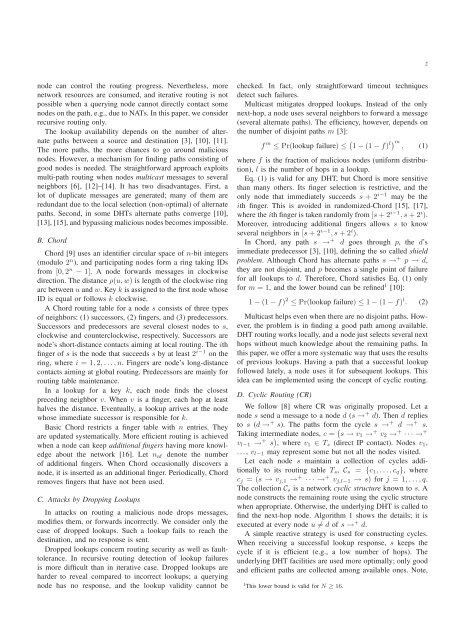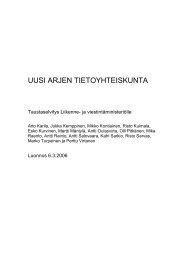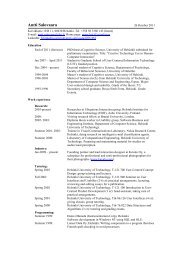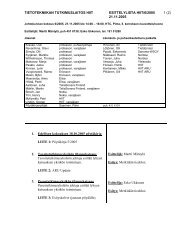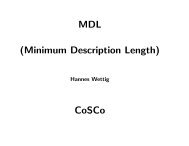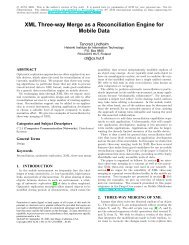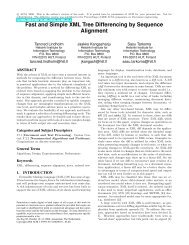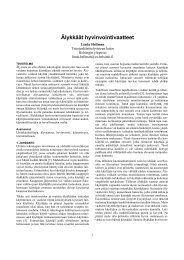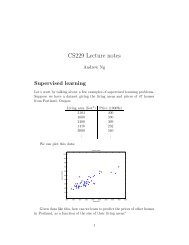Improving Lookup Availability in the Presence of Malicious DHT Nodes
Improving Lookup Availability in the Presence of Malicious DHT Nodes
Improving Lookup Availability in the Presence of Malicious DHT Nodes
Create successful ePaper yourself
Turn your PDF publications into a flip-book with our unique Google optimized e-Paper software.
2<br />
node can control <strong>the</strong> rout<strong>in</strong>g progress. Never<strong>the</strong>less, more<br />
network resources are consumed, and iterative rout<strong>in</strong>g is not<br />
possible when a query<strong>in</strong>g node cannot directly contact some<br />
nodes on <strong>the</strong> path, e.g., due to NATs. In this paper, we consider<br />
recursive rout<strong>in</strong>g only.<br />
The lookup availability depends on <strong>the</strong> number <strong>of</strong> alternate<br />
paths between a source and dest<strong>in</strong>ation [3], [10], [11].<br />
The more paths, <strong>the</strong> more chances to go around malicious<br />
nodes. However, a mechanism for f<strong>in</strong>d<strong>in</strong>g paths consist<strong>in</strong>g <strong>of</strong><br />
good nodes is needed. The straightforward approach exploits<br />
multi-path rout<strong>in</strong>g when nodes multicast messages to several<br />
neighbors [6], [12]–[14]. It has two disadvantages. First, a<br />
lot <strong>of</strong> duplicate messages are generated; many <strong>of</strong> <strong>the</strong>m are<br />
redundant due to <strong>the</strong> local selection (non-optimal) <strong>of</strong> alternate<br />
paths. Second, <strong>in</strong> some <strong>DHT</strong>s alternate paths converge [10],<br />
[13], [15], and bypass<strong>in</strong>g malicious nodes becomes impossible.<br />
B. Chord<br />
Chord [9] uses an identifier circular space <strong>of</strong> n-bit <strong>in</strong>tegers<br />
(modulo 2 n ), and participat<strong>in</strong>g nodes form a r<strong>in</strong>g tak<strong>in</strong>g IDs<br />
from [0, 2 n − 1]. A node forwards messages <strong>in</strong> clockwise<br />
direction. The distance ρ(u, w) is length <strong>of</strong> <strong>the</strong> clockwise r<strong>in</strong>g<br />
arc between u and w. Key k is assigned to <strong>the</strong> first node whose<br />
ID is equal or follows k clockwise.<br />
A Chord rout<strong>in</strong>g table for a node s consists <strong>of</strong> three types<br />
<strong>of</strong> neighbors: (1) successors, (2) f<strong>in</strong>gers, and (3) predecessors.<br />
Successors and predecessors are several closest nodes to s,<br />
clockwise and counterclockwise, respectively. Successors are<br />
node’s short-distance contacts aim<strong>in</strong>g at local rout<strong>in</strong>g. The ith<br />
f<strong>in</strong>ger <strong>of</strong> s is <strong>the</strong> node that succeeds s by at least 2 i−1 on <strong>the</strong><br />
r<strong>in</strong>g, where i = 1, 2, . . .,n. F<strong>in</strong>gers are node’s long-distance<br />
contacts aim<strong>in</strong>g at global rout<strong>in</strong>g. Predecessors are ma<strong>in</strong>ly for<br />
rout<strong>in</strong>g table ma<strong>in</strong>tenance.<br />
In a lookup for a key k, each node f<strong>in</strong>ds <strong>the</strong> closest<br />
preced<strong>in</strong>g neighbor v. When v is a f<strong>in</strong>ger, each hop at least<br />
halves <strong>the</strong> distance. Eventually, a lookup arrives at <strong>the</strong> node<br />
whose immediate successor is responsible for k.<br />
Basic Chord restricts a f<strong>in</strong>ger table with n entries. They<br />
are updated systematically. More efficient rout<strong>in</strong>g is achieved<br />
when a node can keep additional f<strong>in</strong>gers hav<strong>in</strong>g more knowledge<br />
about <strong>the</strong> network [16]. Let n af denote <strong>the</strong> number<br />
<strong>of</strong> additional f<strong>in</strong>gers. When Chord occasionally discovers a<br />
node, it is <strong>in</strong>serted as an additional f<strong>in</strong>ger. Periodically, Chord<br />
removes f<strong>in</strong>gers that have not been used.<br />
C. Attacks by Dropp<strong>in</strong>g <strong>Lookup</strong>s<br />
In attacks on rout<strong>in</strong>g a malicious node drops messages,<br />
modifies <strong>the</strong>m, or forwards <strong>in</strong>correctly. We consider only <strong>the</strong><br />
case <strong>of</strong> dropped lookups. Such a lookup fails to reach <strong>the</strong><br />
dest<strong>in</strong>ation, and no response is sent.<br />
Dropped lookups concern rout<strong>in</strong>g security as well as faulttolerance.<br />
In recursive rout<strong>in</strong>g detection <strong>of</strong> lookup failures<br />
is more difficult than <strong>in</strong> iterative case. Dropped lookups are<br />
harder to reveal compared to <strong>in</strong>correct lookups; a query<strong>in</strong>g<br />
node has no response, and <strong>the</strong> lookup validity cannot be<br />
checked. In fact, only straightforward timeout techniques<br />
detect such failures.<br />
Multicast mitigates dropped lookups. Instead <strong>of</strong> <strong>the</strong> only<br />
next-hop, a node uses several neighbors to forward a message<br />
(several alternate paths). The efficiency, however, depends on<br />
<strong>the</strong> number <strong>of</strong> disjo<strong>in</strong>t paths m [3]:<br />
f m ≤ Pr(lookup failure) ≤ ( 1 − (1 − f) l) m<br />
, (1)<br />
where f is <strong>the</strong> fraction <strong>of</strong> malicious nodes (uniform distribution),<br />
l is <strong>the</strong> number <strong>of</strong> hops <strong>in</strong> a lookup.<br />
Eq. (1) is valid for any <strong>DHT</strong>, but Chord is more sensitive<br />
than many o<strong>the</strong>rs. Its f<strong>in</strong>ger selection is restrictive, and <strong>the</strong><br />
only node that immediately succeeds s + 2 i−1 may be <strong>the</strong><br />
ith f<strong>in</strong>ger. This is avoided <strong>in</strong> randomized-Chord [15], [17],<br />
where <strong>the</strong> ith f<strong>in</strong>ger is taken randomly from [s + 2 i−1 , s + 2 i ).<br />
Moreover, <strong>in</strong>troduc<strong>in</strong>g additional f<strong>in</strong>gers allows s to know<br />
several neighbors <strong>in</strong> [s + 2 i−1 , s + 2 i ).<br />
In Chord, any path s → + d goes through p, <strong>the</strong> d’s<br />
immediate predecessor [3], [10], def<strong>in</strong><strong>in</strong>g <strong>the</strong> so called shield<br />
problem. Although Chord has alternate paths s → + p → d,<br />
<strong>the</strong>y are not disjo<strong>in</strong>t, and p becomes a s<strong>in</strong>gle po<strong>in</strong>t <strong>of</strong> failure<br />
for all lookups to d. Therefore, Chord satisfies Eq. (1) only<br />
for m = 1, and <strong>the</strong> lower bound can be ref<strong>in</strong>ed 1 [10]:<br />
1 − (1 − f) 2 ≤ Pr(lookup failure) ≤ 1 − (1 − f) l . (2)<br />
Multicast helps even when <strong>the</strong>re are no disjo<strong>in</strong>t paths. However,<br />
<strong>the</strong> problem is <strong>in</strong> f<strong>in</strong>d<strong>in</strong>g a good path among available.<br />
<strong>DHT</strong> rout<strong>in</strong>g works locally, and a node just selects several next<br />
hops without much knowledge about <strong>the</strong> rema<strong>in</strong><strong>in</strong>g paths. In<br />
this paper, we <strong>of</strong>fer a more systematic way that uses <strong>the</strong> results<br />
<strong>of</strong> previous lookups. Hav<strong>in</strong>g a path that a successful lookup<br />
followed lately, a node uses it for subsequent lookups. This<br />
idea can be implemented us<strong>in</strong>g <strong>the</strong> concept <strong>of</strong> cyclic rout<strong>in</strong>g.<br />
D. Cyclic Rout<strong>in</strong>g (CR)<br />
We follow [8] where CR was orig<strong>in</strong>ally proposed. Let a<br />
node s send a message to a node d (s → + d). Then d replies<br />
to s (d → + s). The paths form <strong>the</strong> cycle s → + d → + s.<br />
Tak<strong>in</strong>g <strong>in</strong>termediate nodes, c = ( s → v 1 → + v 2 → + · · · → +<br />
v l−1 → + s ) , where v 1 ∈ T s (direct IP contact). <strong>Nodes</strong> v 1 ,<br />
. . . , v l−1 may represent some but not all <strong>the</strong> nodes visited.<br />
Let each node s ma<strong>in</strong>ta<strong>in</strong> a collection <strong>of</strong> cycles additionally<br />
to its rout<strong>in</strong>g table T s , C s = {c 1 , . . .,c q }, where<br />
c j = (s → v j,1 → + · · · → + v j,l−1 → s) for j = 1, . . .,q.<br />
The collection C s is a network cyclic structure known to s. A<br />
node constructs <strong>the</strong> rema<strong>in</strong><strong>in</strong>g route us<strong>in</strong>g <strong>the</strong> cyclic structure<br />
when appropriate. O<strong>the</strong>rwise, <strong>the</strong> underly<strong>in</strong>g <strong>DHT</strong> is called to<br />
f<strong>in</strong>d <strong>the</strong> next-hop node. Algorithm 1 shows <strong>the</strong> details; it is<br />
executed at every node u ≠ d <strong>of</strong> s → + d.<br />
A simple reactive strategy is used for construct<strong>in</strong>g cycles.<br />
When receiv<strong>in</strong>g a successful lookup response, s keeps <strong>the</strong><br />
cycle if it is efficient (e.g., a low number <strong>of</strong> hops). The<br />
underly<strong>in</strong>g <strong>DHT</strong> facilities are used more optimally; only good<br />
and efficient paths are collected among available ones. Note,<br />
1 This lower bound is valid for N ≥ 16.


